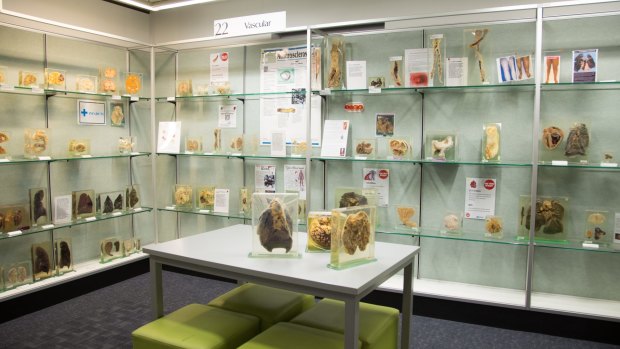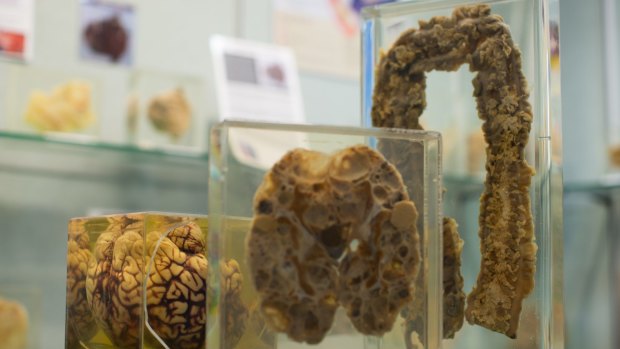This was published 3 years ago
Museum of Human Disease, University of NSW: Australia's most disturbing museum is not for everyone

Choose your body part ... then find out all the terrible things that can happen to it at the Museum of Human Disease.Credit: Louise Reily
Like a mad scientist in a Victorian-era novel, the first thing to do at the Museum of Human Disease is choose your body part. Do you want to wander towards the stomach section to admire a tapeworm like an ivory ribbon folded into a jar? Do you want to investigate the liver, and see how excessive alcohol turns it from pretty pink into something that resembles a lump of rhino hide?
Or maybe you could shuffle over to the cabinets that hold specimens of pancreas and gallbladder. After all, you have one of each, so you ought to find out what they look like, and what they're for. Only problem being, you won't exactly see normal ones. This is a museum for when things go horribly wrong.
The Museum of Human Disease at the University of NSW began as a collection for training medical students, until a pathology professor thought it would also be useful in educating the wider community. Today its 2500 specimens cover nearly everything that kills us in Australia, from heart attacks and strokes to lung cancer and diabetes.

While the exhibits can be disturbing, their educational qualities can have a positive effect.Credit: Louise Reily
Choose your body part via the museum's app and it will send you off on a guided tour of this weird and confronting collection, and provide you with all the information you want – and some you'd rather do without – concerning your innards.
At first, you'll be distracted by the most eye-catching displays. There are things floating in formalin that look like extras from an alien movie. You'll be startled by blackened smoker's lungs, a truly awful gangrenous foot, and a disembodied hand that you expect to spring into action like Thing from The Addams Family.
After a while, though, you'll realise these body parts are neither embarrassing, botched nor simply there as a form of weird entertainment. Each was once attached to a real human being, and the app goes a good job of telling their personal stories.
In a world where surface physical looks seem to count for everything, you also get a unique glimpse into the human interior and how it too is affected by carelessness, poor lifestyle choices and ageing.
One of the positives of this gruesome collection is that some diseases such as typhoid that were once big killers in Australia have been reduced to mere museum displays. Anti-vaxxers should be sent here to see the windpipe of a six-year-old who died in 1960 of diphtheria, eliminated in Australia through public vaccination programs.
You could say this is a celebration of medical science and how it has overcome many horrible diseases. The other good news is that we can all take measures in disease prevention. The museum's major message is that changing our attitudes to alcohol and drug consumption, diet, exercise and smoking would go a long way to reducing the incidence of Australia's biggest killers.
While we hear that a lot, nothing quite reinforces the message like staring at an actual cholesterol-clotted artery, or a tar-filled lung. That can be a grim and unsettling experience – certainly this museum isn't for everyone – but you might actually find yourself departing feeling surprisingly optimistic. You might even be energised into paying more attention to your unseen and neglected innards. And who doesn't need some positive health encouragement in these trying times?
DETAILS
MORE
VISIT
Normally open 10am-4pm weekdays. While the museum is temporarily closed due to COVID-19, you can take a virtual tour online. It is set to reopen in January.
See also: The racist camp that one in 20 Australians are connected to
Sign up for the Traveller Deals newsletter
Get exclusive travel deals delivered straight to your inbox. Sign up now.